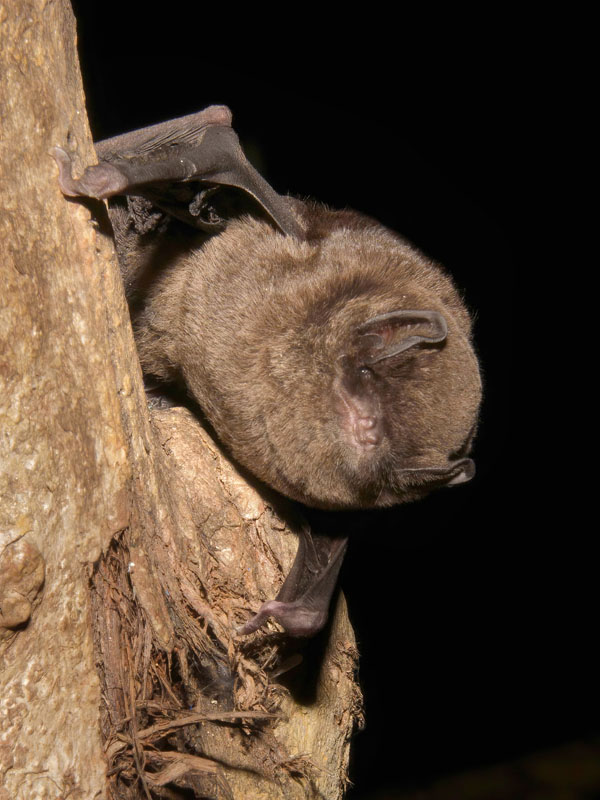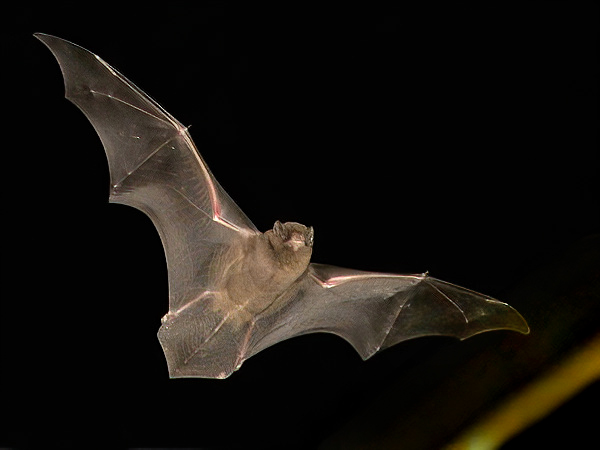
Fig 1

Fig 2

Fig 3

Fig 4
|
Order : CHIROPTERA
Family : Miniopteridae
Species : Miniopterus spp.
Forearm Length :
species range between 34 and 53 cm
Weight : species range between 10 and 16 grams
Bent-winged or
long-fingered bats (Miniopterus spp.) possess a relatively long terminal
bone of the middle finger, compared to the
middle bone, and thus the terminal portion of the wing is folded backwards and
neatly tucked underneath the rest of the wing when roosting.
Globally around 40 species of Miniopterus are
recognised, of which at least 12 are known to occur in Southeast Asia. They
occur in a huge range of elevations, from lowland habitats to 3,200 metres above sea
level on the island of New Guinea.
There are great similarities between all species of Miniopterus, which are
often distinguished only on the basis of forearm length and body weight.
Identification of species on the basis of photographs alone is difficult.
Featured here are images of Miniopterus magnater (Large Bent-winged
Bat, Western Bent-winged Bat), a medium-sized member of the genus, taken in
Papua New Guinea; the species also occurs in a number of locales within
Southeast Asia including Borneo, western Java, Timor, Seram, and parts of mainland
Southeast Asia (see map in Armstrong et al, 2021).
In all species of bent-winged bat the fur is thick and typically brown to brownish-black, but sometimes reddish-brown. The ears are relatively small and rounded, and the eyes
are small.
Many bent-winged bats roost in large colonies in caves; in tropical rainforests, where karst
limestone habitats provide cave systems for roosting, such colonies can
number over 100,000, for example in parts
of Borneo. These colonies are socially organised: it is known that
thousands of juveniles may be left together by night under the care of a few
females while their parents are out foraging for food.
Bent-winged bats feed on flying insects,
particularly moths, high in the forest canopy. They will also forage at
street lights near forested areas, where flying insects are attracted.
Figs 1 to 3 : These bats are identified as Miniopterus magnater (Large
Bent-winged Bat). All photos are from Southern Highlands Province, Papua New Guinea, in
montane forest at 1920 metres elevation.
(The bats in Figures 1 and 3 were both found hanging from a barbed wire
fence; in both cases the interfemoral membrane had snagged on one of the
short metal spikes. The weakened bats were retrieved in the morning, kept warm and allowed
to recover, and then photographed and released the next evening.)
Fig 4 : Gomantong Cave, Sabah,
Borneo; a renowned roosting site for great numbers of bent-winged bats and
other species.
References :
Armstrong, K.N., Wiantoro, S. & Aplin, K. 2021. Miniopterus magnater
(amended version of 2019 assessment). The IUCN Red List of Threatened
Species 2021: e.T13566A209529644
Bonaccorso, F.J., 1998. Bats of Papua New Guinea. Conservation
International, Tropical Field Guide Series 2.
Francis, C. M., 2019. Field Guide to the Mammals of South-east Asia. Second
Edition. Bloomsbury Publishing. 416 pp.
Acknowledgments : Thanks to
Frank J. Bonaccorso for assistance.
|